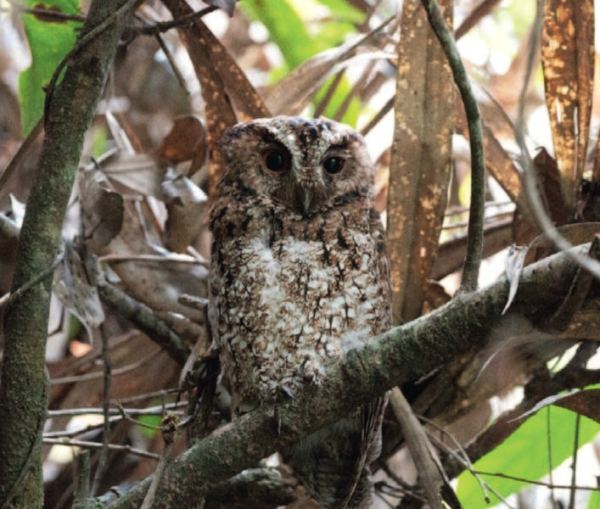
The rediscovered Bornean Rajah Scops Owl was photographed by Andy Boyce.
|
A super-rare subspecies of Rajah Scops Owl found only on the island of Borneo that hasn’t been observed by biologists since 1892 was observed and photographed on the slope of Mount Kinabalu in northwest Borneo, in the Sabah state of Malaysia. Almost all basic elements of this birds’ ecology remain unknown, including vocalizations, distribution, breeding biology, and population size. Additionally, biologists believe this subspecies may be a separate species, and the need to protect the owls is quite obvious to all.
It all started when Andy Boyce, an ecologist with the Smithsonian Migratory Bird Center, was studying how different bird species behave across various elevations on Mount Kinabalu in collaboration with local residents, Sabah park officials, and several individuals from indigenous communities including the Dusun. While in the field, Boyce received a text message from Keegan Tranquillo, who first spotted the bird, and quickly alerted Andy about an odd-looking owl with orange eyes.
“Out of this dark corner where there was a lot of vegetation, this owl flew out and landed,” Tranquillo described. While he was observing the owl, it flew away, but he was excited when it returned to perch in the shadowed area shortly afterward. “It’s a stroke of luck it came back to that exact spot!”
Although Andy Boyce was not actively looking for the owl during his research, he immediately thought of the endemic scops owl after reading the message. He rushed down a trail to the location where the owl was still perched, and while trying not to disturb the owl, Dr. Boyce and other researchers meticulously photographed and documented the wondrous bird. The owl was about 25 percent larger than other owls found in the area according to Boyce. He assumed the scops owl weighed about 4 ounces, similar to a North American screech owl.
“If we didn’t document it right then and there, this bird [and the species it represents] could disappear again for who knows how long,” Boyce explained. “It was a really rapid progression of emotion. There was nervousness and anticipation as I was trying to get there, hoping the bird would still be there. Just huge excitement and a little bit of disbelief when I first saw the bird and realized what it was. And then, immediately, a lot of anxiety again.”
Boyce suspects a Bornean Rajah Scops Owl hasn’t been seen such a long time because their population density is low. Researchers are not sure where the species’ core habitat is located, leaving them with little knowledge of where the owl could be found again. Even if biologists knew where to look, the owls’ nocturnal tendencies likely make them even harder to find. Covored in plumage with shades of gray, black, and dark brown, this owl didn’t have the usual rufous tinge to the plumage of more common owls in the region. But its piercing orange eyes gave its true identity away.
After returning every day for almost 2 weeks, and even a few nights each week, Boyce was unable to find the owl again. Using standard procedure, researchers would normally visit potential habitats at night to listen for calls, but no one knows what the owls sound like. Knowing the owl’s song could also play a role in helping biologists understand if the owl may be a distinct species rather than a subspecies.
Several of Borneo’s bird species are “endemic only to that island,” Boyce explained, increasing the likelihood of the owl being a distinct species. Its partner subspecies is found on the neighboring island of Sumatra in western Indonesia, but very little is known about the differences between the 2 subspecies. From a conservation perspective, documenting the super-rare owl proves its existence, which is a vital first step for protecting and conserving the subspecies.
Anyone Can Contribute to New Discoveries
The excitement of this mystery emphasizes how anyone can contribute to new discoveries. With cell phones and other new technology, many people have the capability to spot and document wildlife, as long as it’s done in a safe and ethical manner. “In this case, the team that made the discovery were scientific researchers, and they were doing a project. But equally, it could have been accomplished by some local birders,” noted one biologist.
This rediscovery also serves as an empowering and humbling reminder that there are endless discoveries waiting for people who are willing to go out and look. There is power in “scientific humility,” Boyce said, in which embracing the unknown is a worthwhile endeavor rather than something to be feared.
“It reminds us as humans, and as scientists, that there are things and there are places in this world that we still just don’t have a grasp of; and we’re still surprised by things that we find,” noted Dr. Boyce.
The original article that appeared in Smithsonian magazine was written by Gia Yetikyel, which can be reviewed online at https://www.smithsonianmag.com/smithsonian-institution/owl-documented-first-time-more-than-125-years-180977722/
To access the research publication in the Wilson Journal of Ornithology titled: Rediscovery of Rajah Scops Owl on the island of Borneo, see https://bioone.org/journals/the-wilson-journal-of-ornithology/volume-132/issue-3/20-50/Rediscovery-of-Rajah-Scops-Owl-Otus-brookii-brookii-on-the/10.1676/20-50.short